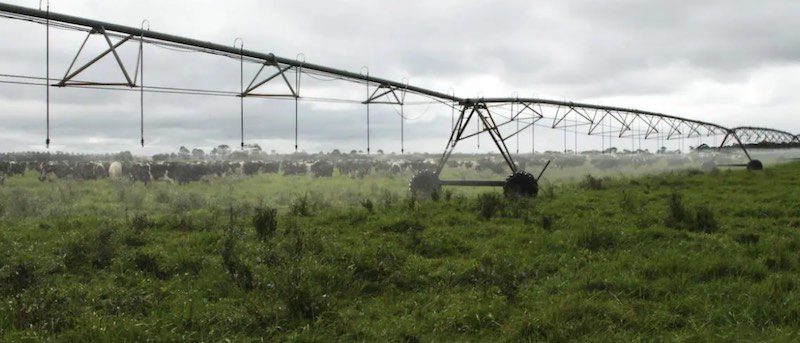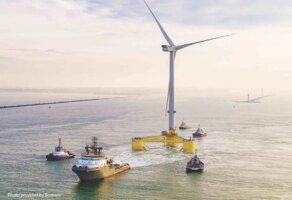Two Gippsland organic dairy farmers have cut their irrigation-related energy costs from $80,000 to just $1200 after making substantial investments in renewable energy and equipment upgrades on their Victorian farm.
Sandra Jefford and Wilco Droppert produce milk, silage and hay on their Clydebank dairy farm in eastern Victoria, where energy bills averaging $10,000 per month drove the pair to explore cost-cutting measures.
“We milk about 380 cows year round, and our energy bills were just too big for our size farm,” said Jefford.
Consecutive years of poor agricultural conditions including dry weather and flooding sent irrigation costs through the roof, and threatened the sustainability of the farm’s operations as a whole.
“You had to question whether it was viable to keep dairy farming here,” said Jefford.
The bills drove the pair to commission an agricultural audit in 2018, with support from Sustainability Victoria. The initial audit recommended a series of equipment upgrades to bore pumps and pipelines – projecting up to $18,000 in savings.
But it was the implementation of renewable energy which ultimately transformed the farm’s operations, reduced the pair’s reliance on the grid and slashed their energy costs.
Their story is one of many being talked about in the farming community as the Australian agricultural sector continues to explore the potential for renewables to help farmers drive down costs and improve farm-wide energy efficiency.
Load shifting with renewables
After winning a grant from Agriculture Victoria’s Energy Investment Plan, Jefford and Droppert installed 200kW of solar power to aid irrigation practices across the farm.
Adapting the installation of solar panels to the ebb and flow of the dairy farm’s operations has been key to maximising their utility.
“We used to irrigate mainly at night using off-peak power, whereas now we do most of the irrigation during the day using solar,” said Jefford.
Jefford says the panels have been fenced off to avoid damage from cattle, and have been installed to face north, east, and west to make the most of them across the day.
“Lots of people install their solar panels all facing north, but we want power from as early in the day as we can, and as late in the day as we can so we can irrigate as much as possible.”

The software controlling the solar network communicates with the upgraded infrastructure to trigger irrigation with the power available in the system at any one time. Crucially, the automation means that the system will stop drawing on energy and water resources when something goes wrong, reducing waste, and costs.
As a result of the changes, the cost to irrigate per kW hour it dropped from 24 cents to -3 cents per kW hour, taking the farm’s total irrigation costs down from $80,000 to $1200.
The pair also have plans to extend the use of renewables on the farm to include wind turbines. The farm is on track to integrate 30kW of wind power which will allow for the irrigation and pumping of water late into the day.
Central to Jefford’s approach is a drive to make renewables work with the complexities of the changing conditions.
“In the early afternoon during our irrigation season we get an easterly breeze. We came here in 2011, and I was saying to my husband: ‘Why don’t we have wind turbines, this is crazy! We should be using the wind instead of cursing it every afternoon!’”
Climate change complicates farming’s future
There is considerable optimism surrounding the application of renewables to dairy farming, and agriculture more broadly, as concepts such as agrisolar and solar grazing gather steam.
But unpredictable weather patterns and a changing climate continue to complicate farmers’ abilities to integrate new technologies.
Jefford and Droppert’s farmland’s proximity to low lying river and lake systems makes it particularly vulnerable to coastal weather events. Successive floods across a 12 month period have caused parts of the farm to remain permanently wet, leaving Jefford to ponder whether the land can still be farmed at all.
“If we keep getting these kinds of La Nina weather conditions, will we actually have the use of that land for grazing in the future?” she asks.
Nevertheless, the pair’s drive to adapt their practices on the land persists.
“If [the land] is going to be under water that often, maybe we just plant it with things that like those wet boggy conditions, or leave it for the frogs.”
Jefford is involved in efforts to maintain local biodiversity, and the pair have already responded to guidance from the local catchment authority to fence off 20 hectares of wetlands from cattle in order to protect local wildlife, such as endangered frog species.

Renewable (and affordable) futures
There are further plans to improve the energy efficiency and carbon neutrality of the farm, including the development of a microgrid, electric replacements for quad bikes, and a goal to expand on the 5000 trees planted on the property in the last few years.
But Jefford says they are not the only farmers in the area consciously considering the environmental sustainability of their operations.
“There’s definitely other landowners looking at change partly because they can save money, and partly because they really care about the environment,” she said.
“It’s definitely beneficial for us to make these changes, it makes farming more interesting, more exciting.”
The project is expected to pay itself off in seven years’ time and Jefford hopes it will remain something of a legacy for those next operating the farm.
“We’ll keep managing the farm until this is paid off, and then if our kids want to take over it’s going to be much easier for them. Who knows what the next challenge will be, but at least they’ll have free power!”










